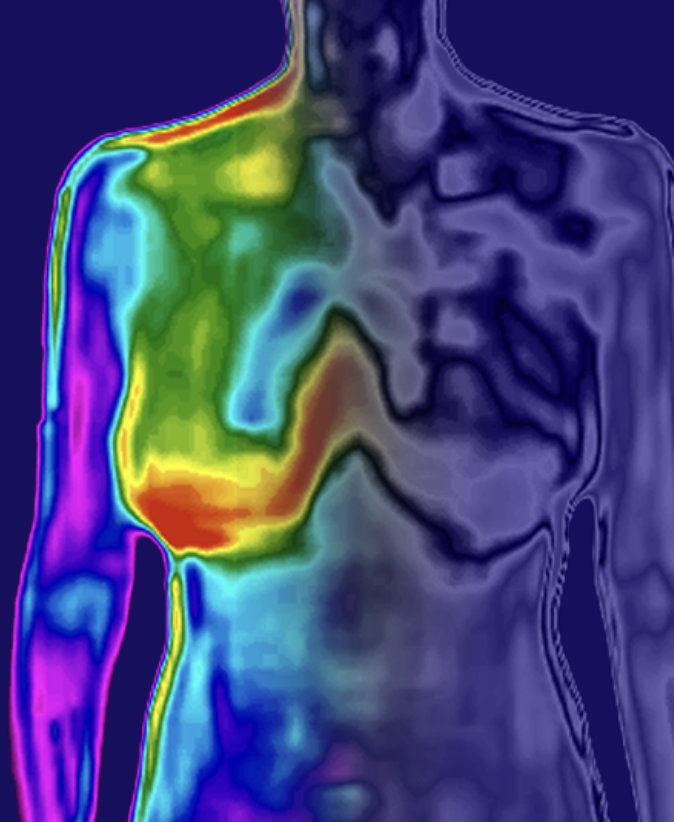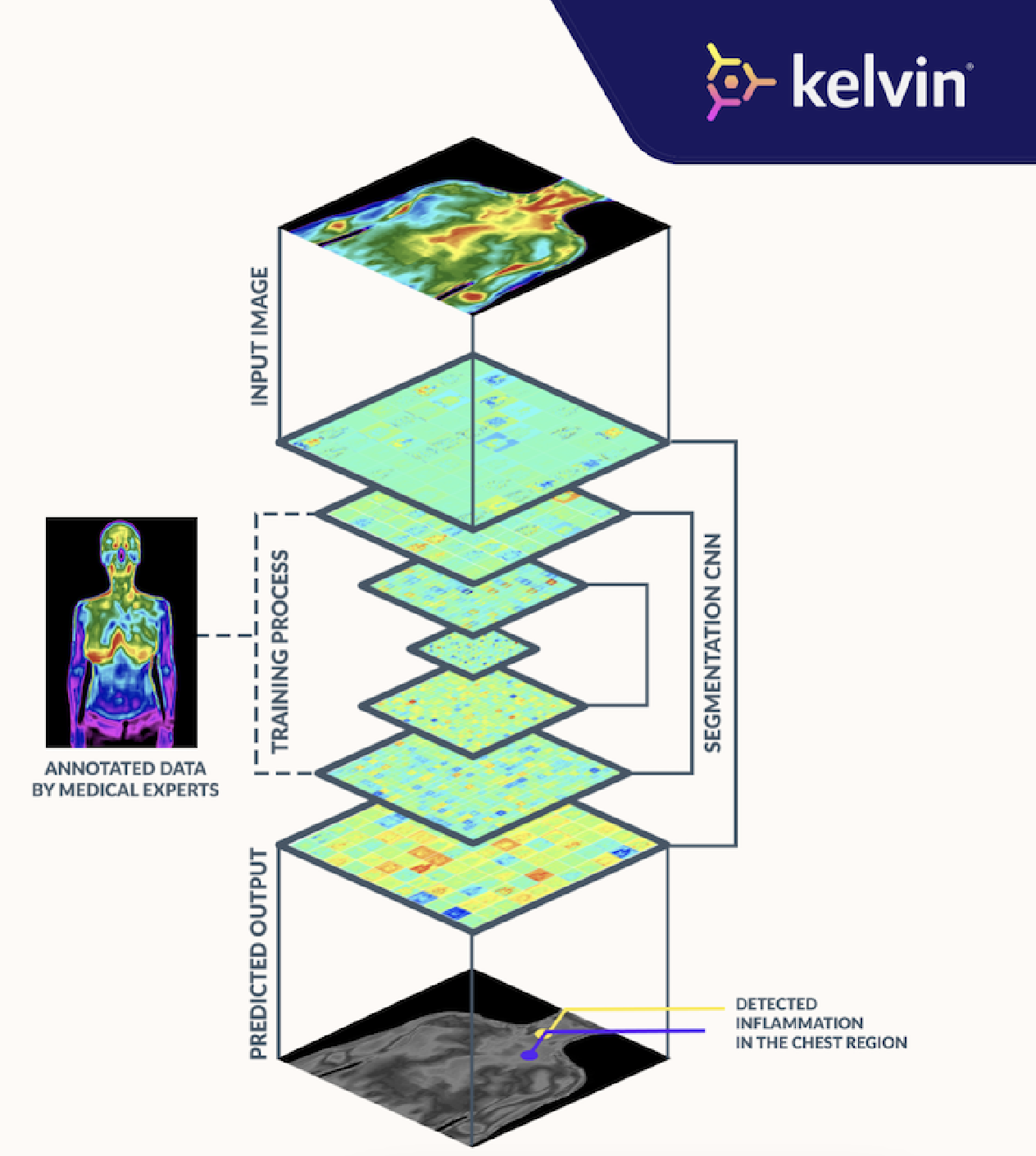Kelvin Health
Accessible mobile screening tool empowered by AI analysis of thermal images that significantly reduces the risk of breast cancer undercare.


THE COMPANY
Why Do We Exist
Our body is killing us by constantly hiding symptoms until it’s too late.
Kelvin Health changes that by providing a widely accessible intelligent tool that uncovers hidden anomalies in the human body.
Empowered by AI analysis of thermal images, Kelvin Health significantly reduces the risk of breast cancer undercare by providing a cost and time efficient screening and monitoring approach which leads to wider, earlier, and more relevant intervention by health care providers and pharma companies.
The application of Kelvin Health results in healthier population, better healthcare providers’ ratings and cost savings for the intermediaries.
The primary focus of the project are patients in risk groups and subject to screening and preventive care, or such that are currently subject to active therapy that needs to be monitored.
The Problem
According to WHO more than 70% of people, even in developed economies, avoid timely examinations or have fear of visiting hospitals (even more now in COVID-19 times) for invasive or radiation-emitting procedures.
Besides pursuing career, “Sandwich Generation” mothers aged between 35 and 54 experience more stress than any other age group owing to the delicate and demanding balancing act of caring for their children and their aging parents, which leave little to no space for preventive care initiated by them using the existing approaches.
In remote and/or underdeveloped regions the access to healthcare and specialists is very limited due to financial and/or logistical hurdles, creating significant health inequality.
The above factors greatly increase the chances of serious health conditions, such as developing breast cancer, being left undiagnosed/unmonitored for a period of time long enough to lead to severe complications.
The International Agency for Research on Cancer reported a total of 18,078,957 cancer cases worldwide in 2018 including 2,088,849 breast cancer (11.6%) cases, making it the second most frequent type. Breast cancer was the most common cancer among women that accounted for 24.2% of the cases. The disease is the leading cause of cancer death in over 100 countries.
Who Has This Problem
The primary focus of the project are patients in risk groups and subject to screening and preventive care, or such that are currently subject to active therapy that needs to be monitored, for the following health conditions (visualised with real-life images captured by the Kelvin Health application): a) oncology and breast cancer (our current focus), in particular, b) autoimmune and rheumatoid arthritis, in particular, c) vascular and thrombophlebitis, in particular, and d) respiratory infections and COVID-19 in particular:

Here are statistics regarding the cancer pandemic worldwide and the significance of breast cancer in particular. The UN has forecasted that the global population will reach 8.3 billion by 2030 (United Nations 2019). The effect of population ageing and growth will be greatest in low-income and middle-income countries. These changes translate to a predicted global burden of 20.3 million new cancer cases by 2030 compared with an estimated 12.7 million cases in 2008, and a predicted 13.2 million cancer-related deaths worldwide by 2030, up from 7.6 million in 2008 (Pilleron S 2020; World Health Organization 2018) .
The International Agency for Research on Cancer reported a total of 18,078,957 cancer cases worldwide in 2018 including 2,088,849 breast cancer (11.6%) cases, making it the second most frequent type (Bray 2018). Breast cancer was the most common cancer among women that accounted for 24.2% of the cases (Bray 2012).
The disease is the most frequently diagnosed female cancer in the vast majority of the countries (154 of 185) and is also the leading cause of cancer death in over 100 countries (Bray 2012).
Globocan and other authors (Bray 2018; All Cancer Globocan 2018) have predicted a 50% rise in the number of prevalence in breast cancer by 2040.
Cancer registry data clearly show that early detection of breast cancer (lower TNM stage) is associated with better survival (Ng, 2009). Detection of non-invasive breast cancer (ductal carcinoma in situ, DCIS) exhibits a relative survival of affected women of > 94%. For invasive breast cancers of < 1 cm, relative survival after 15 years ranges from 90 to 92%; for tumors of 1–2 cm, it ranges around 75% and continues to drop with increasing T stage. On average, the death rate increases by 1.3% per millimetre increase in size. With increasing tumor size at detection, a shift towards higher grading becomes visible. All these facts support our knowledge that early detection has a significant impact on prognosis (tumorregister-muenchen).
Early detection of breast cancer could increase the survivability rate up to 90% of all cases within a five-year window, thus, the need of an easy- access, cheap and trustable breast cancer screening method still latent in underdeveloped countries (Ng, 2009).
The management of patients with breast cancer has a significant impact on the national budget. It is, therefore, a public health priority to support effective prevention programs that could reduce cancer costs or provide therapeutic interventions that increase patients’ chances of survival, thus reducing the indirect costs of morbidity and mortality. The reality of the cost burden is evidenced by numerous studies; for example, Smidova 2012 showed that the productivity loss related to breast cancer in Poland amounted to 583.7 million EUR in 2010 and 699.7 million EUR in 2014. During this period, this amounts to 0.162–0.171% of the GDP. Public finance expenditure for social insurance benefits to breast cancer sufferers ranged from 50.2 million EUR (2010) to 56.6 million EUR (2014), or 0.72–0.79% of the total expenses for all diseases. Loss of opportunity in public finance revenue amounted to 173.9 million EUR in 2010 and 211.0 million EUR in 2014.
Unar-Munguıa et al., 2017 estimated that 245 million USD in medical expenses and income lost due to breast cancer could be spared over the life of a cohort of Mexican women. Medical costs account for 80% of the economic burden; loss of income and opportunity costs for careers represent 15% and 5%, respectively.
In contract to all worrying statistics above, the results of the thermography can be correct 8–10 years before a mammogram can detect a mass in the body of the patient. In addition to this, a shortage of qualified radiologists has caused an urgent need for the development of computer technologies like Computerized Thermal Imaging (CTI), which analyzes and interprets a series of infrared images using algorithms that correlate infrared data regarding the breast being examined with infrared models associated with benign or malignant breast tissue. It does not require any physical contact, and there are no liquids to drink. Furthermore, it does not use ionizing radiation, making it highly preferable in diagnostic procedures for pregnant women and younger women (Mambou S 2018 and Mambou S 2018).
Our Solution
Kelvin Health is an intelligent tool for detection and monitoring of various abnormalities and inflammation processes in different health conditions (currently focused on breast cancer) and stages, using AI analysis applied to mobile-based digital thermal imaging.
Inflammation is best characterized by four symptoms, commonly stated in Latin: calor (heat), dolor (pain), rubor (redness), tumor (swelling). Researchers have used thermal imaging in a broad number of diseases where the increased skin temperature (calor) reflects the presence of inflammation in underlying tissues or regions where blood flow is increased or decreased due to medical irregularities.
The IR (infrared thermal) imaging does not require any physical contact, it is non- invasive, allows for unlimited throughput and there are no liquids to drink. Furthermore, it does not use ionizing radiation, making it highly preferable in screening and monitoring for people of various age and risk groups.
Combining the expertise of medical and AI professionals, we have developed a system consisting of a thermal IR camera connected to a mobile device or a desktop computer, a unique thermal image segmentation algorithm, and a ML (machine learning) based software to analyze the thermal images received.


How Does It Work
Combining the expertise of medical and AI professionals, we have developed a system consisting of a third part thermal IR (infrared) camera that can be connected to a mobile device or a desktop computer, a unique thermal segmentation algorithm, and a ML (machine learning) based software to analyze the thermal images received.
Key factor for the successful implementation of the technology is the quality data collected and its proper pre-processing, as well as the optimization of the ML models for detection and segmentation of the tumors in this data.
We apply our extensive experience in ML-based image recognition for the latter part of the tasks.
For the former, we count on clinicians that are properly trained by us on how to collect the data using the thermal camera and our capturing software (mobile application).
THE TEAM
Georgi Kadrev, CEO
- Pioneered the image recognition API concept model in 2011.
- Brought Imagga to the global innovator IDC spot in 2016.
- Invited international speaker in AI, technology innovation and entrepreneurship.
Georgi Kostadinov, CTO
- Architected the largest commercial image recognition model with 100K+ categories, 150M sample images and 97% top-5 accuracy
- Forbes Bulgaria 30-under-30 for 2020.
Tanya Raynova, VP of Regulatory Affffairs
Served as Head of Public Relations of the Supreme Administrative Court of Bulgaria for 8+ years.
Evgeni Kosev, VP of Business Development, Europe
Attracted and managed a total of $195M highly competitive public funding for innovation activities in the last 8 years.
Chris Georgiev, VP of Business Development, Asia-Pacific
Firestarter of the biggest startup events in Bulgaria and established AI networking events in Seoul.
Pavel Andreev, VP of Product
Product manager of the first global automated image recognition AI platform.
Ivaylo Mihaylov, Medical Data Coordinator
Served as Manager of High Sport Achievement evaluations in the National Sport Academy for 3 years.
Maria Sharkova, Legal Adviser
Medical law specialization in the US.
Miena Stoycheva, Business Adviser
Chair of the Digital Health and Innovation Cluster, Bulgaria CEO of JA Bulgaria.
Mladen Mladenov, M.D., Medical Adviser
Renowned breast cancer specialist in 1st Gynaecological Hospital “St. Sofia”.
Evgenia Alexandrova, Patient Affairs Adviser
- Chairman of the Association of Cancer Patients (APOZ)
- Patient advocate and consultant certified by ECCO, ESMO, ECPC, UICC, EUROPA DONNA
- National Representative of the European Breast Cancer Coalition EUROPA DONNA
- Contact person, CANCER MISSION, HORIZON EUROPE Framework Program.
THE RISKS
Generic Risk Statement
Unlike other imaging methods the technology behind Kelvin is non-invasive, non- damaging, and with an unbound frequency of use as it doesn't emit ionizing radiation.
The main risks involved are regarding the specificity and the sensitivity of technology. It's important to reduce to the absolute minimum the chances that problematic cases are missed, as well as false alerts are raised when there is no problematic condition.
For that purpose we are building a very diverse dataset, spanning over different geographies, ethnicities, age groups and stages.
Additionally, complying to the regulatory processes and ensuring the future compliance of the solution with FDA and CE mark would provide the standard level of trust and the proper labelling and understanding of both specialists and consumers about the expected accuracy of the solution and the guidelines for its usage.

